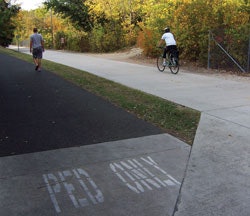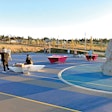Active transportation advocates aggressively push the recreation and economic benefits created by trails.

That's why Rails-to-Trails, a nonprofit that works with municipalities throughout the nation to promote the development of trails, has introduced to the U.S. Congress a groundbreaking report that strives to quantify for the first time various existing and potential benefits of bike and pedestrian trails.
"What we're after in the long run is to change the idea of trails as things that are very popular but considered by many to be just a nice amenity, to being an essential community asset, the kind of thing that you need in order to have a complete city," says Mills. "We have long participated in these national debates, and we come in with lots of good reasons to support active transportation, but a lot of the debate will end up focusing on returns on investment and cost-benefit contexts. We wanted to be better positioned to speak in those terms."
In the short run, the group is after the attention of national political leaders, as this year Congress will be mulling over the reauthorization of the Safe, Accountable, Flexible, Efficient Transportation Equity Act: A Legacy for Users, which authorized nearly $286 billion between its ratification in 2005 and 2009 on surface-transportation infrastructure and programs throughout the country.
But, as Mills notes, the issue shouldn't merely be of interest to transportation professionals. "Congress is going to care most about the mobility benefits of trails and how they relate to the bill," he says. "But looking at all the benefits, you see that these are resources that are enjoyed immensely in a recreation context. Trails help create places where people want to live - where they can walk or bike to both work and play."

"Be sure to ask them which trails they might find most valuable for transportation purposes - especially if you're hoping to spend some of the kind of money that they typically get," says Everhart, who recommends the collaboration early in the planning process to make sure trails are successfully integrated not only with roadways, but also with other recreation facilities such as parks. "You should actually be counting and monitoring trail usage," she says. "Do the same kind of counts that your transportation bureau does, so you can demonstrate things like peak-hour commuter use."
Portland is one of many U.S. cities that have reaped the positive economic and quality-of-life rewards that trails can help create. The city is host to numerous bike-related conferences each year; it boasts a high rate of bike commuters as well as a successful bike rental program; and the trails themselves (some of them fancy enough to be called "esplanades") are viable economic engines. "They are tourist destinations just as much as are our big, well-known rose gardens," says Everhart.
Though Rails-to-Trails didn't quantify potential tourism revenue in its report, the group did conclude that more developed local trail systems in U.S. cities could potentially result in tens of billions of dollars worth of benefits. The report cites data showing that approximately half of the one-way trips in the United States are three miles or less in distance. According to the report, 9.6 percent of those trips are made on foot or by bicycle. Thus, an estimated 23 billion drive-miles a year are avoided, resulting in fuel savings of 1.4 million gallons, CO2 emissions savings of 12 tons, and a substantial increase in physical activity and subsequent decrease in health-care costs - all of which add up to an estimated $4.1 billion per year.
Accounting for modest hypothetical increases in bicycle/pedestrian travel (up to 13 percent of short trips) and substantial hypothetical increases (25 percent), the report estimates that the total monetary value would increase to $10.4 billion and $65.9 billion per year, respectively. Those numbers, Rails-to-Trails argues, dwarf the infrastructure investment that would be required to make possible the increased trail usage.
The group even asked more than 40 communities what they would do if $50 million were given to them for trail development. The answers, which essentially came in the form of detailed case studies that often included scores of pages of background information and planning data, indicated tremendous local enthusiasm, says Mills, as well as numerous assertions that such an investment in trails would have positive effects on the local economy and environment.
"One of the things that we see consistently is a high degree of understanding at the local level of how doing a trail project - which has some utilitarian value, as well as some quality-of-life and conservation value - serves a number of positive purposes at once," he says. That understanding is sometimes lost at the state and national levels of government, he says, where the policy-making process dictates that issues are often discussed independent of one another.
"You're dealing with a committee structure, and if you're talking about something like climate change, they only want to hear the two or three items that matter most to climate change," Mills says. "They don't care to hear a kind of five-for-the-price-of-one solution. But at the local level, they often can connect those dots."
But having those case studies, part of what Mills describes as the grassroots effort to improve trail development nationwide, "gives us the ability to approach those decision-makers and say, 'This is a real opportunity. There is a lot of transparency here about what you'd be buying if you decide to make this investment.' "
Mills acknowledges that given the current economic crisis, including the $700 million financial industry bailout and (as of this writing) more talks of an auto industry bailout, advocacy for federal-level funding of any kind presents some serious challenges. Adding to the problem is that the nation's highway trust fund, which is fed through a gas tax and used to support U.S. highway and bridge projects, had by last September essentially dried up as a result of lower gas consumption amid record-high prices.
That kind of financial strain has certainly trickled down to the local level, and Everhart likewise suggests that trails projects can be a tough sell. "It can be as much as $1 million a mile to build these off-street trails," she says, "so you are definitely duking it out with other recreation demands."
That's why Mills believes quantifying the potential benefits of trail development has become essential. "For the first time," he says, "we have enough information and enough of a methodology that we can begin to put numbers to these benefits."
That's not to say that Mills, himself a longtime bike commuter, and other trails advocates find any great pleasure in crunching numbers. "We always get so serious because we're operating in a policy realm," he says. "But from a personal standpoint, the fact that you physically feel better and can actually enjoy your trip to work or to play is what keeps you doing this."
































